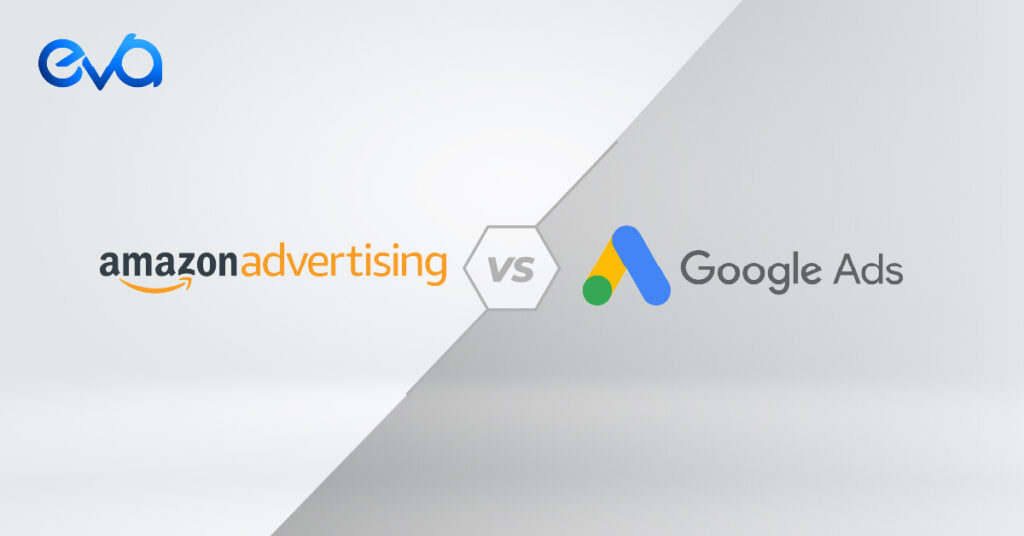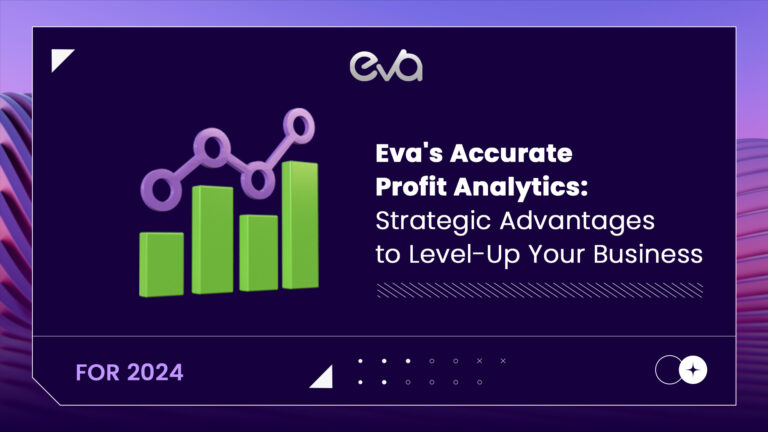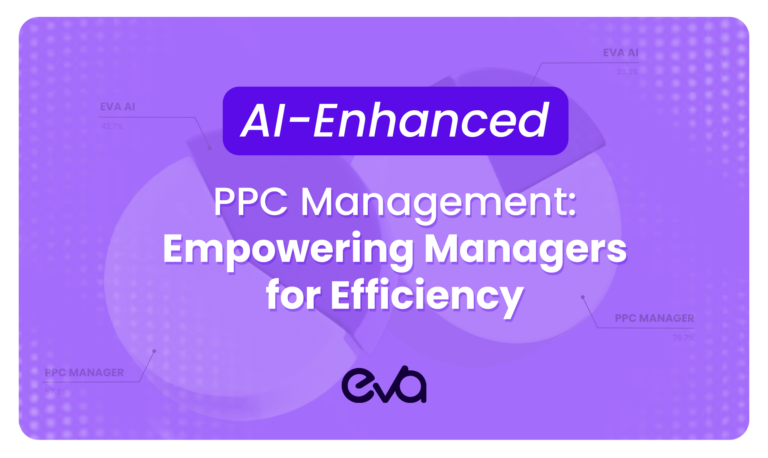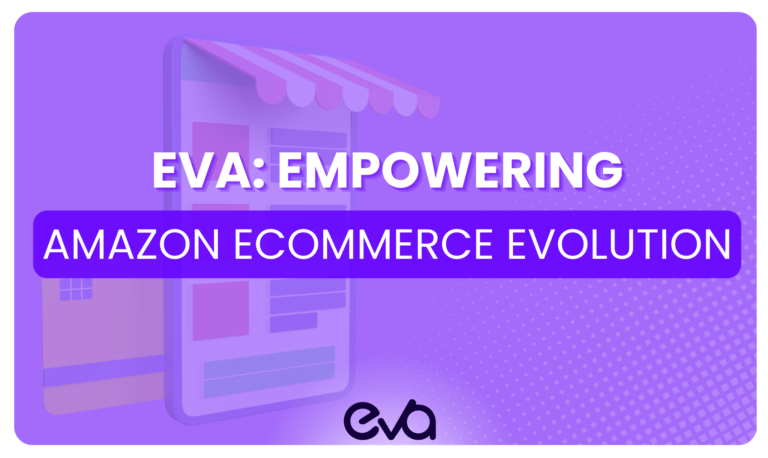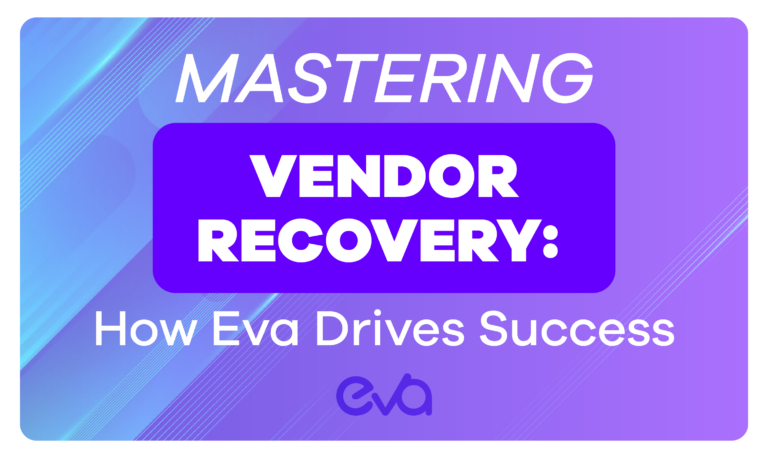2021 was a big year for Amazon. The retail giant cemented its place as the dominant player in online commerce, with sales surpassing $280 billion. But what does this mean for Amazon’s advertising business? This blog post tries to find the winner of the “Google Ads vs Amazon Ads” battle to help you see which one is more profitable in 2023.
🚨Spoiler alert: it’s Amazon Ads! Keep reading to find out why.
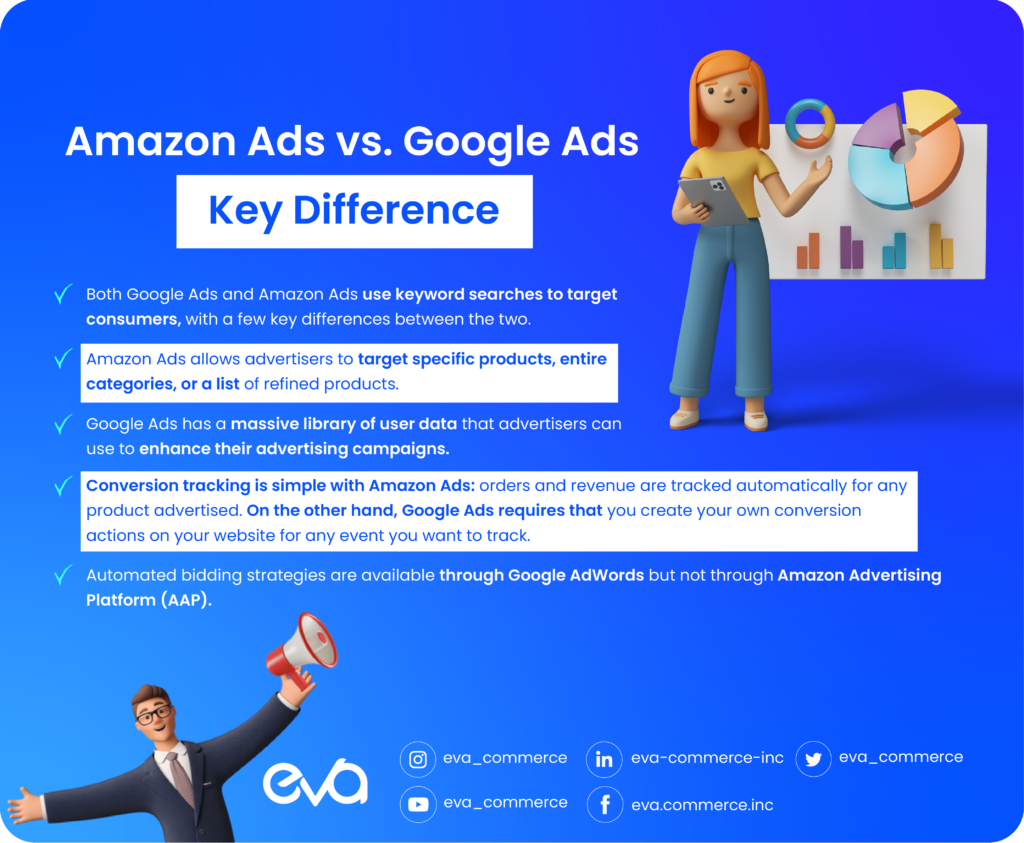
Read More: Google Ads for Amazon Products: The Golden Key to External Traffic
Table of Contents
- Google Ads vs Amazon Ads: The On-going Battle
- How Much Does Amazon Spend on Google Ads?
- How Do the Auctions work on Amazon Ads?
- How Do the Auctions work on Google Ads?
- What are the Ranking factors for Amazon Ads?
- What Are the Ranking Factors For Google Ads?
- Google Ads vs Amazon Ads: The Key Differences
- Amazon Ads or Google Ads, Which One is Winning the Online Advertising Battle?
- Conclusion
Google Ads vs Amazon Ads: The On-going Battle
In the olden days, Amazon was for shopping and Google for searching. That hasn’t changed, but many people have turned to Amazon (rather than Google) to search for, research, and compare products.
Shoppers are migrating to search on Amazon.
Statistics show that about 55% of product searches now happen on Amazon versus Google. A survey of more than 2000 U.S. consumers confirmed this preference, with 66 percent of participants saying that Amazon was their first stop when looking for a new product, not Google.
Companies, including Amazon, have taken notice of this change and have begun to ramp up their advertising budgets.
So many eCommerce companies are investing in Amazon Ads.
Amazon has made a jaw-dropping investment in its advertising platform since 2018. Amazon rebranded its advertising services and then merged its Amazon Marketing Services (AMS), Amazon Media Group (AMG), and Amazon Advertising Platform (AAP) into one consolidated brand and application: Amazon Advertising. Google attempted a similar rebranding in 2018 by relaunching its advertising platform, Google AdWords, as Google Ads.
Like Amazon Ads, Google Ads has many advertising options, ranging from the display, video, and search. While the rebranding was a success for Amazon, the company’s advertising platform was already taking off. In 2018, Amazon’s year-over-year (YoY) advertising revenue grew nearly 120 percent.
In comparison, Google Ads grew by 17 percent. Even though they claim the largest share of the digital advertising market, making it difficult for the tech giant to experience Amazon-like growth in 2018, Amazon’s growth is still noticeable. One reason for this is the U.S marketplace. With digital advertising spending in the U.S., more than 65 percent of businesses use online advertising.
Top of over $100 billion in 2019. For advertising platforms like Amazon Ads and Google Ads, online advertising provides significant revenue.
Marketers are increasing Amazon ad spend
Google already generates $17 billion in annual advertising revenue. In comparison, Amazon generates about $10 billion. However, the accelerated growth of Amazon’s advertising platform threatens to impact Google’s ad revenue and other platforms such as Facebook.
Companies have started shifting from Google Ads to Amazon Ads. For example, about 50-60% of consumer-packaged-goods (CPG) advertising spending, which comprises the budget of brands such as Unilever and Procter & Gamble, has moved from Google to Amazon. These are some of the largest advertisers in the world, emphasizing their impact on advertising revenue and advertising market share.
That is why digital advertising is now a battleground for Amazon and Google.
See Also: How Can Google Ads Benefit Your Amazon Marketing Strategy?
How Much Does Amazon Spend on Google Ads?
The biggest online retailer in the world is Amazon, and Google is the biggest search engine. The fact that Amazon spends a lot of money on Google ads should not be shocking. Walmart is Google’s top advertising customer, with Amazon coming in second, and spent $10.8 billion on Google advertisements in 2022!
That is so much money! But it’s also a wise financial decision. Amazon makes sure that its products and services are prominently displayed when people search for them online by spending money on Google ads. And the results show up in higher sales and a larger market share. Therefore, don’t be surprised if Amazon keeps spending a lot on Google ads in the future.
How Do the Auctions work on Amazon Ads?
Amazon uses a “second-price auction,” which means that you’ll pay a slightly higher amount than the second-highest bid instead of paying your bid amount when someone clicks on your ad. So if you bid $2 and the next highest competitor’s bid was $1.50, you’d pay $1.51 or a little over $1.50 for a click.
It’s pretty straightforward, but that doesn’t mean you can win ad placements 100% of the time just by making the highest bid. Amazon Ads also uses an algorithm to calculate which ads are most relevant to search and eligible to be displayed, but what it involves is a bit of a mystery.
We know from Amazon: “Ads selected to compete in the auction must first contain keywords that match the search and meet the minimum relevance criteria.”
How Do the Auctions work on Google Ads?
Google Ads has a similar model but is more transparent about how ad quality affects the auction process. Google uses various signals and real-time data to determine Ad Rank, which measures the quality of your ad for a search. Your bid, ad relevance and estimated click-through rate, and even the user’s location and type of device are used to calculate Ad Rank.
You should note that Ad Rank is considered when calculating CPC, so you don’t pay slightly higher than the next highest bid for a click. However, if you have a high Ad Rank, you can win better ad placements and pay less per click than your competition.
What are the Ranking factors for Amazon Ads?
In online advertising, Ad Rank is synonymous with Google. However, other advertising platforms like Amazon Advertising have adopted Ad Rank and customized it to their platform, audience, and needs. That is because relevance is vital in online advertising.
If users don’t get any relevant ads, nobody wins. Your company doesn’t connect with potential customers, which doesn’t drive you to online advertising or that platform. That’s why Amazon and Google evaluate every ad.
Knowing what Google and Amazon look for when scoring ads is essential for your advertising campaigns to be successful. This way, you can create high-quality, relevant ads that perform better in ad auctions and generate better ROI for your eCommerce business. When evaluating ads, Amazon Ads looks at the following factors:
Note: Amazon Ads is not a pay-to-win platform. A high bid does not mean you will win the auction. However, it can make your ad more competitive or compensate for lower-quality advertising. Your company wants to make competitive but strategic bids for the best results.
 Keyword relevance:
Keyword relevance:
The keywords in your ad (and your product page, if you’re promoting a product) help Amazon determine your ad’s quality and relevance. Targeting the right keywords can help your business reach the right audience.
 Accurate product listing:
Accurate product listing:
Ads create expectations, so it’s essential to have product listings, which act as landing pages, to coordinate with your ad. For example, a promotion for a hairbrush that visits the product page of shampoo will not appeal to users.
 Complete listing:
Complete listing:
For Amazon and shoppers, it’s helpful if your business provides as much information about your products as possible. So when grading ads for products sold on Amazon, Amazon refers to the completion of the listing.
 Buy Box Eligibility:
Buy Box Eligibility:
If you are advertising products as an Amazon seller, the Buy Box eligibility of your product will also affect your Ad Rank. You want your product to be eligible for the Amazon Buy Box and its winner for best results.
Competitive bidding and targeting the right keywords are essential when creating Amazon Ads. However, you should also provide everything users need to know about your product and get the motivation to buy it when it comes to Ad Rank.
What Are the Ranking Factors For Google Ads?
Bid: Google Ads also looks at how much you are willing to pay for someone to click on your ad. Again, a higher bid does not necessarily mean that you will win the auction. You can often bid low if you create a high-quality ad and still get the ad auction.
 Expected Click-Through Rate (CTR):
Expected Click-Through Rate (CTR):
Google Ads also looks at your CTR, or how likely people are to click your ad. If you have a low CTR, it usually means that your ad is not relevant to users, which can affect how often it is shown to your audience.
 Ad Relevance for Search:
Ad Relevance for Search:
It is essential to create a relevant ad for a high Ad Rank. You can refine your keyword or audience targeting to make your ad relevant to users. For example, a local business may limit its advertising to a specific area.
 Landing page experience:
Landing page experience:
When people click on your ads, Google wants to make sure they have a positive experience. So Ad Rank considers the landing page experience. The best landing pages follow what your advertising promises and provide users with what they want.
 User discovery context:
User discovery context:
Personalization is an essential part of the online experience. So Google’s Ad Rank looks at the search context of the user. It also considers their location, time of day, equipment, and even their past search behavior.
 Estimated impact of extensions:
Estimated impact of extensions:
With Google Ads, your business can use ad extensions to enhance your advertising by providing your phone number. If these extensions improve your ad’s relevance and user experience, they can increase your Ad Rank.
Compared to Amazon Ads, Google Ads looks at many different factors when determining Ad Rank.
Google Ads vs Amazon Ads: The Key Differences
Keyword targeting
Both platforms use keyword searches as their primary method of targeting consumers. Both allow advertisers to use precise, phraseological, and broad keyword match types. And the definitions of the two are virtually the same between the two advertisers.
Both Google Ads and Amazon Ads also include close variants for exact match keywords. However, Google is again more transparent when it comes to defining close variants.
Product targeting
The unique advantage of Amazon Ads is using products instead of keywords as the target of ads. Instead, advertisers can target specific products, entire categories, or a list of products that you refine based on brand, star rating, and the number of reviews.
Automatic targeting
Again, Amazon Ads has gained a foothold on Google Ads with its unique automatic targeting capabilities. Advertisers can use automated targeting for their sponsored product campaigns and let Amazon handle the keyword research.
Using automatic targeting, Amazon matches ads with similar products and keywords. Users can then view a list of search terms and products where your ad appeared. That brings valuable information about which keywords and products you should use or avoid in your manual targeting campaigns.
Audience and Demographic Targeting
Hands down, Google wins this arena. Google has a massive library of user data that advertisers can enhance their advertising campaigns. For example, data such as age, gender, household income, hobbies and interests, equipment, and relationship status can target and exclude users from your campaigns.
You can set the percentage to adjust bids to make your audience highly focused on keyword bidding. For example, let’s say you know that moms between the ages of 25 to 44 are more likely to buy your new running stroller. In that case, you can increase your bidding for those demographics. That helps you ensure that your ads reach your target audience as much as possible. Almost all of Google’s advertising products allow you to use these capabilities, giving you a few options to play with as you improve your advertising strategy.
However, Amazon only has similar targeting capabilities for Amazon DSP (Demand Side Platform), Amazon’s Display Network offering. In addition, audience and demographic data are not supported by a sponsored product, sponsored brand, or sponsored display campaigns.
Conversion Tracking
Conversion tracking with Amazon Ads is simple: orders and revenue will be tracked automatically for any product you advertise. On the other hand, Google Ads requires that you create your own conversion actions on your website for any event you want to track, whether a purchase or lead form submission. That allows advertisers to track important events beyond just purchases, such as when someone adds a product to their cart.
A conversion tracking setup might be a pain for first-timers. However, Google provides complete documentation to help you through this, and their customer support team can assist you.
Automated Bidding
Google Ads offers several fully automated bidding strategies that eliminate the tedious task of bid optimization. For example, with a bidding strategy like Target ROAS or Maximize Conversions, Google will automatically set keyword bids and optimize for you based on your goals and the performance of your campaigns. This further simplifies campaign management and eliminates the need to spend hours customizing bids regularly.
Amazon Ads doesn’t offer fully automated bidding strategies like Google. So you’ll need to set keyword bids manually or use software to manage bids, such as pattern forecasting software. However, Amazon Ads has two automatic bid adjustment features that can dynamically raise and lower bids for you based on conversion potential.
The Advertising Cost
Whether your business advertises online, the cost is an essential factor. Of course, you want to create a realistic pay-per-click (PPC) advertising budget, but you also want to earn ROI. That’s why it’s helpful to review advertising costs on Amazon or Google.
Compared to Amazon Ads, Google Ads doesn’t require your business to set a minimum bid or budget. Instead, your company can create a bidding strategy that supports your ad spend and business goals.
However, it’s worth noting that your ad spend will affect your results. That is because Google’s Ad Rank uses your bid as a factor. So if you bid too low, it can prevent your ad (no matter how relevant) from reaching your audience. That’s why you should create a realistic advertising budget.
Amazon Ads or Google Ads, Which One is Winning the Online Advertising Battle?
Google Ads has dominated most of the digital advertising market, but Amazon Ads shows exceptional growth and the potential to smother ad revenue. That’s why digital marketers now plan to increase their Amazon ad spend by 25 percent. Not to mention, Amazon boasts of a lower CPC and higher conversion rates than Google.
Even though Amazon Ads claims all these benefits, this platform is not logical for every company. However, it’s convenient for the companies that are selling on Amazon to leverage the platform. It’s difficult for businesses outside of the Amazon marketplace because of advertising prices. Display advertising (the only option for companies that don’t sell on Amazon) requires an ad spend of $35,000. For small to medium-sized businesses (SMBs), this is a high upfront price for an ad, which limits display ads to more prominent brands.
Google offers companies of all sizes the ability to advertise online, but an eCommerce store may see Amazon Ads as the clear winner, and a local service area business may see Google as the unanimous choice for growing businesses. However, we can generally conclude that Amazon Ads are the more profitable option for most eCommerce businesses.
Conclusion
So what does all this mean for Amazon Ads? First, it means that the retail giant is cementing its place as the dominant player in online commerce, with sales surpassing $280 billion in 2022. This is great news for Amazon’s advertising business, which is expected to be more profitable than Google Ads by 2023.
If you’re looking to invest in digital marketing, it’s definitely worth considering Amazon Ads! If you’re already advertising on Amazon, we highly recommend getting Eva’s free PPC audit to reach the highest potential of your current Amazon PPC campaigns with the lowest ACoS and highest conversion rates ever! Eva is one of the preeminent Amazon advertising agencies with the perfect solution for your business.
Feel free to book a face-to-face call with us anytime if you need more information about the PPC audit.

